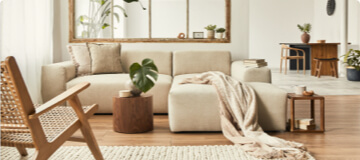When choosing flooring for your home, there are a wide variety of options available, including bamboo flooring. It has gained a great deal of attention since its introduction into the flooring world, particularly because of its sustainability compared to timber. But if you’re considering this environmentally friendly alternative, you may be wondering what are the bamboo flooring pros and cons?
What is bamboo flooring?
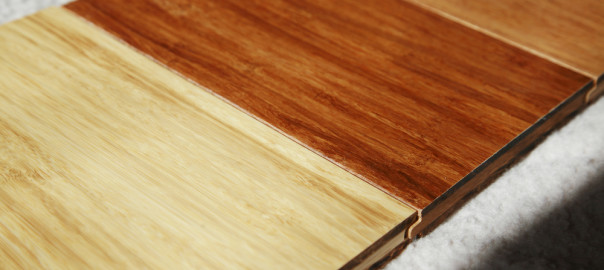
Bamboo flooring installed in a hallway
Bamboo flooring was introduced to the Australian market around 20 years ago. In terms of aesthetics, it closely resembles other engineered wood products, yet it is crafted very differently. The process involves boiling steaming raw bamboo grass to remove sugars and starches from the natural plant material
It is then dried, and the strands of raw, dried bamboo are then sliced, shredded, woven and pressed with glues, resin binders and heat. Typically, a hydraulic press will compact the bamboo into a square log which is eventually cut down to plank size for processing into floorboards.
The result is solid engineered bamboo planks or engineered planks with a top layer of bamboo. They are typically glued or nailed to a subfloor surface.
What is the history of bamboo flooring?
Bamboo flooring first entered the market around twenty years ago. It was soft, expensive and very unstable. Choice was also limited in terms of colour — only “natural” and coffee (which was carbonised) colours were available, both came in gloss and semi-gloss versions and were constructed vertically and horizontally.
This early product used a tongue and groove glue-together installation method (like most floating floors at the time), and it was sometimes directly stuck to the floor, which proved to be a huge mistake! This is because bamboo grows and contracts on average two and a half times an engineered timber floor, making boards unstable and prone to splitting. Additionally, compared to Australian hardwoods, it was quite soft (weighing only 7 on the Janka Scale) and showed damage easily.
Cold pressing
Strand weaving was a different practice from the vertical and horizontal methods, and the first woven bamboo flooring method of manufacturing was referred to as “cold pressing”. Instead of being formed from rods of bamboo that were essentially just glued together, strand woven bamboo was sliced into strands.
These strands were then dipped in adhesive, left to dry and then placed into a mould. This was heated and pressed, putting the bamboo under pressure while activating the adhesive. It significantly increased the hardness and density of the bamboo, more than doubling its Janka rating. Around this time, locking systems also became available for hard flooring, and this is where bamboo flooring entered the mainstream market. This enabled flooring to be laid faster than earlier versions, thus decreasing its cost.
Manufacturers, particularly from Asia, imported bamboo flooring at this time in huge volumes. However, a lot of the product entering the market was improperly cured and not always evenly dried. This meant the boards on the outside of the blocks often had a lower moisture content which made the product prone to splitting through the centre of the plank.
Hot pressing
In an attempt to avoid this problem, a new method of strand weaving was invented, known as “hot pressing”. Like cold-pressed bamboo, the bamboo strands were moulded, but this mould was differently shaped, allowing more bamboo to be loaded into the mould, creating a product with a higher density. Additionally, because the mould was much thinner, the “cooking” time was greatly reduced.
The product was denser and more stable than cold-pressed bamboo and exceeded 16 on the Janka scale. However, the colour of the bamboo fluctuated dramatically and was often very different to the samples the consumer viewed before purchasing.
How do bamboo floors differ today?
Colour
Three shades of bamboo flooring
Today, most bamboo flooring is blonde or light amber, and this is often the result of the bamboo strips being boiled in bleach. It can also be darkened into a coffee colour by a process of carbonisation, whereby the bamboo strips are streamed or “smoked” under extreme heat to caramelise the sugar in the fibre.
Style
There are three main styles of bamboo flooring:
Vertical bamboo flooring
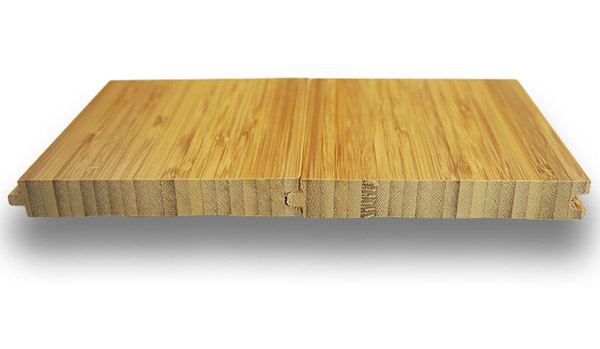
Vertical bamboo flooring. Image from Bamboo Flooring Company
Bamboo is cut into thin, small strips, dried and vertically glued together to create a flooring plank. A machine is then used for the addition of the “fitting profile” (typically a tongue and groove design). Layers of lacquer are then applied to form a protective barrier and to finish the floor. The outcome is a slat of solid bamboo flooring with a thinner, “striped”, and more subtle grain pattern.
Horizontal bamboo flooring
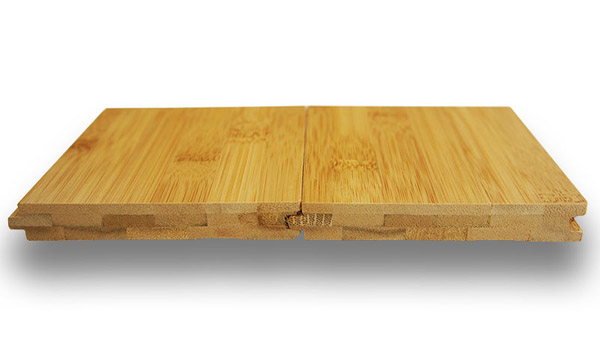
Horizontal bamboo flooring. Image from Bamboo Flooring Company
For this type of bamboo flooring, the initial process is the same as above, but the flooring is horizontally glued together. The outcome is a slat of solid bamboo flooring that has a broader, more obvious grain pattern.
Strand woven bamboo
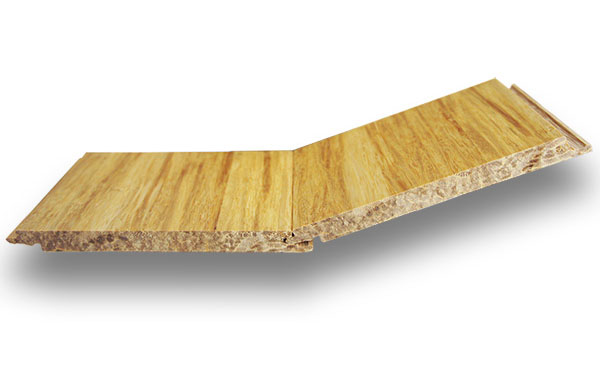
Strand woven bamboo flooring. Image from Bamboo Flooring Company
Bamboo is shredded into stands and fibres, then dried and compressed with extreme pressure to create planks with an interlocking pattern. The outcome is a plank or block of flooring that has a random grain pattern. This type of bamboo flooring is much stronger, more versatile and more expensive than vertical or horizontal bamboo flooring. It typically has either a tongue and groove or “click fitting” profile and is available in various plank sizes.
What are the pros of bamboo flooring?
When it comes to bamboo flooring pros and cons, let’s start with the positives! Here are the pros:
- Durable — Quality bamboo flooring is exceptionally hard and dense. It is harder than some hardwoods! As such, it is tough and structurally stable, potentially lasting for many years with regular maintenance. It is also termite-resistant.
- Sustainable – Bamboo flooring is generally sustainable and eco-friendly. Bamboo plants grow quickly, so they are rapidly renewable and can be harvested every five or six years. Bamboo flooring that is crafted overseas may contain formaldehyde and other glues which emit toxic volatile organic compounds (VOCs). However, it is illegal to import any timber or bamboo flooring that does not meet strict Forestry Stewardship Criteria, which will be evident on the product box as an FSC logo. This means the product is logged responsibly from sustainable forests and is free of harmful toxins. Before purchasing, you should also check its E1 rating (which is the amount of formaldehyde in wood products).
- Aesthetic appeal — It offers a clean, modern and contemporary look and, depending on the thickness of the planks, can be re-finished.
- Easy to clean — If finished properly, bamboo is easy to clean with a mop and a mild soapy water mixture, so ideal for your kitchen and bathroom.
- An investment — It can add value to a home.
- DIY-friendly — If the flooring has a top layer that’s glued to multiple sub-layers.
- Cost — Bamboo flooring is a cheaper alternative to timber flooring, and although prices vary, professional installers typically quote between $80 and $90 per square metre to lay it. This includes not only laying the material but also preparing the surface, installing underlay and removing and replacing skirting boards. Bamboo suppliers will also often give discounts for larger quantities of flooring. For example:
- Up to 30 square metres of standard grade bamboo flooring can cost $55m2
- 85 to 175 square metres of the same flooring can cost $50m2
- 250 square metres or more can cost as little as $45m2
What are the cons of bamboo flooring?
Like all flooring, bamboo floors also have their cons:
- Uniformity — Unlike hardwood flooring, bamboo has a distinct grain pattern that is quite generic, whereas timber and engineered wood floors are unique. The colours available are also limited.
- Knuckles — These are nodes or natural growth rings on bamboo stalks and are evident in particularly horizontal wood flooring, which some people find unattractive.
- Damage susceptibility — Inexpensive, low-quality flooring can shrink after installation causing it to crack and form gaps and be susceptible to dents and scratches.
- Water absorption — Bamboo easily absorbs water, leading to flooring being vulnerable to humidity, warping, swelling, shrinkage and buckling.
- Fading — Over time, bamboo flooring can fade, discolour and become marred.
Bamboo flooring Gold Coast
If you’re looking for bamboo flooring on the Gold Coast, contact or visit Ashmore Carpets today!
References
- 2021, Bamboo Flooring Pros and Cons, Impact Floors
- Dean Billett, 2020, Bamboo flooring: The history, pros and cons, and how to decide if it’s right for you, Online Flooring Store
- 2021, Types of bamboo flooring, All Flooring WA
- 2021, Bamboo Flooring, Bamboo Australia
- Rob Schneider, 2021, What are bamboo flooring prices like in 2021? hipages


